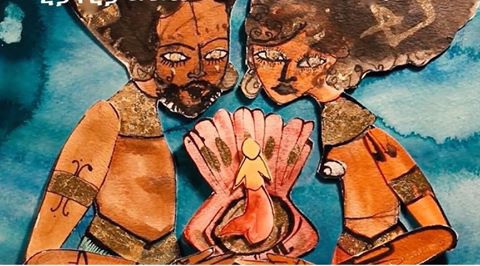
Recently the Alliance Ethio-française, Addis Ababa had organized a film screening and a question-and-answer program based on a film entitled The Water Will Carry Us Home. Through living ritual and stop motion animation, the film made by Gabrielle Tesfaye, relates the story of stolen Africans who were thrown off a slave ship when sailing through the Middle Passage. Upon falling into the sea, the unpredicted happened when mermaids, who dwell in these waters, soothed the slaves’ spirits.
“The Water Will Carry Us Home” is an award winning short film, currently on its international tour and presented for the first time in Ethiopia. Following the show of the film, Gabrielle had made a discussion with the audience, in addition to an exclusive footage preview of her upcoming film, ‘Yene Fikir, Ethiopia’.
Film story
When the film kick starts, accentuated by costumes and smoke Gabrielle is seen scouting for spirits. She also performs a special movement what she called a call of spirits to communicate with deities. “It is this way story tries to ram home about the deities and their power of savoring. And the scene included in the film tips the audience something about the main essence. “
According to Gabrielle, the film is inspired by a West African folkloric story about the time of the trans-Atlantic slave trade. During the time, black people were caught and transported by ship from Africa to South America, North America, and the Caribbean and so on.
And this story has been narrated among the Diaspora community estranged from their native land for long. As a member of the Diaspora community born from Ethiopian and Jamaican parents, Gabrielle heard such a story so many times. It is about the slaves thrown off the ship into the ocean. In the story, the thrown slaves would turn into mermaids when they landed in the water from a water deity sperm.
The film is made to commemorate those slaves who passed away in the water at the time. The film is all about the faith of the people who belabor the water will carry them back home (Africa). “It is just about symbolizing the water as a spirit that has a divine power to do so.”
On the other hand, the mermaids who play important role to save the people thrown into the sea are black deities, casted up on the folkloric story. Therefore the characters are the mermaids called Amaya (ocean deity), Alegua (opportunity opener), Oya (wind) and Chango (lightening) deities.
They are the protectors of the slaves. In the opening, Gabrielle appears ceremonially praying accentuated by smoke. She said that the performance introduces the religious nature (deities’ miracles) of the film in an abstract form. Then the cartoon characters seen as commuters conduct the falling and rescuing acts.
Why animation?
“I am primarily a painter. I have been painting all my life. But I upgraded the film to animation to make it more stories telling as motion picture. In this regard I tried to narrate the folklore of black people. I think it was successful. The film tour has covered Kenya, Thailand, India, Indonesia, Engalnd, Brazil, Canada and all over America. Recently Ethiopia and Los Angeles were included in the list.
Awards
The film had won the Cream City Cinema Filmmaker Award, she said. She also got 2,500 USD grant from the Brico Forward Fund Grant in 2018 (a US based film making award) to properly complete her next film, Yene Fikir Ethiopia. “My presence here is also very significant to this end. I visited various places and I met with many Ethiopians to have a proper grasp and the real image of the country.”
She thought that the animation film making is not popular in Ethiopia but it will take shape in recent years. When they get inspired appreciative of its unique art form, she believed that artists will develop it as their carrier. Her film in the pipeline is mainly intended to show Ethiopia more to the world.
Ethiopia is a land of origins and logically the source of human history. Therefore, knowing about Ethiopia can be taken as knowing the world history. She wants all Ethiopians to be proud of themselves as they have history and culture worth to crow about.
Perception to be corrected
Most people in the developed countries [especially in the West] still assume Ethiopia to be synonymous to famine and drought; they need to be sensitized more about this country that boasts ancient civilization and aura of invincibility. However, the country is more than that. Ethiopia is the land of numerous natural wonders and social gifts.
“I want to crisscross the country filming Lalibela, Gondar, Bahir Dar and Harar. I will focus on people’s life in the big cities. I also aim at demonstrating the large scope of Ethiopia to entertain its past and present feature of the country.”
Attendees’ reaction
It was invited by his friend Tegenu Tefera attended the film. Animation movies of this nature that has critical content ought to be promoted and developed in our country. Individuals that have such a bent ought to get the necessary material or technical support.
In her Second film footage, Gabrielle could show us about our country’s spellbinding touristic spots including Lake Tana, Nile falls, Lalibela, Harar city among others. She also tries to afford us a peek into some of the majestic places that we never gave attention to. Among these are found narrow streets, the walls and windows of our traditional houses, the market and pieces of moments in our daily routines. I hope the footages will be produced into a significant film that can show the glimpse of our country.
Kiya Feyisa attended an animation film for the first time. As to him, the film proved a hit when it comes to reflecting the black history especially the era of slave trade.
“The film is very impressive. I never thought that an animation film have power to give a glimpse of such vast history. However, the film maker managed to show an impressive black history and successfully reflected the pain of the slaves.”
Story to be continued
In the final minutes of the film, Gabrielle appears again on the screen to tell the audience that the power and duty of the deities have still continued warding off misfortunates. She reveals this by listening to the movement underneath of the water via a headset made up of a wire and water shell plugged into a sand of a lakeshore.
The story continues as the narration of West African “The Water Will Carry Us Home,” keep going among the black people regarding the savoring nature of deities of those who are thrown into the water.
The Ethiopian Herald June 16/2019
BY YOHANES JEMANEH





